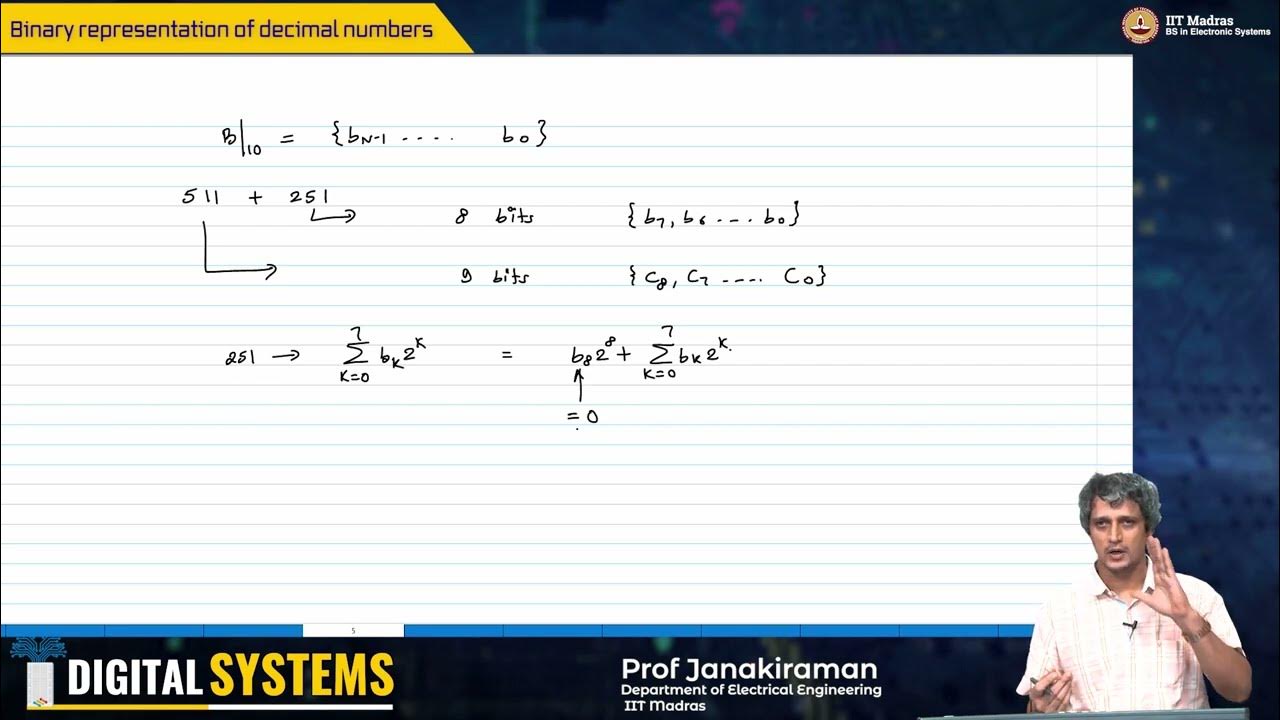Addition of Unsigned Binary
Summary
TLDRThis video covers the basics of adding unsigned binary numbers, explaining the key rules for binary addition. The presenter demonstrates how to handle simple and more complex binary sums, emphasizing how to apply carries when needed. The script walks through practical examples, showing step-by-step how binary digits are added according to set rules. It also explains how to check the results by converting binary numbers into decimal. The video is a helpful guide for beginners learning to perform binary addition and verifying results through decimal conversion.
Takeaways
- 😀 Zero plus zero equals zero in binary addition.
- 😀 Zero plus one equals one, and one plus zero also equals one in binary.
- 😀 One plus one in binary results in '10', which is a carryover, not '2' as in decimal.
- 😀 The binary value '10' represents the decimal number 2.
- 😀 To check binary addition, you can convert the result to decimal to verify correctness.
- 😀 Example 1 demonstrates the addition of binary numbers with carry-over and decimal verification.
- 😀 The decimal conversion for binary 0.11 is 0.75, showing how to validate binary addition results.
- 😀 Example 2 uses an 8-bit unsigned binary addition, including carry-overs and verifying with decimal.
- 😀 Carrying over in binary involves adding the carry to the next higher bit, continuing until no carry remains.
- 😀 Binary addition and verification can be done by converting each bit's value into decimal and adding them together.
Q & A
What is the main advantage of unsigned binary numbers?
-The main advantage of unsigned binary numbers is that they do not involve negative numbers, simplifying the addition process.
What is the result of 1 + 1 in binary addition, and why?
-The result of 1 + 1 in binary is 10 (which is written as 0 with a carry of 1). This happens because, in binary, there is no digit for 2, so it carries over to the next column.
How is the binary value of 10 interpreted in decimal?
-In binary, 10 represents the decimal value of 2. This is because the rightmost 0 represents 0, and the leftmost 1 represents 2.
How can you verify the correctness of a binary addition result?
-To verify a binary addition result, convert both the binary numbers and their sum to decimal and check if the decimal sum matches the result of the binary addition.
What happens when you add 1 + 1 and there’s a carry-over in binary?
-When 1 + 1 occurs in binary, the result is 10. The 0 is written in the current column, and the 1 is carried over to the next column.
What are the binary addition rules outlined in the script?
-The binary addition rules are: 0 + 0 = 0, 0 + 1 = 1, 1 + 0 = 1, and 1 + 1 = 10 (carry 1).
Why does 1 + 1 in binary equal 10 instead of 2?
-In binary, the number system only has two digits: 0 and 1. Therefore, when 1 + 1 is computed, it results in 10, which represents 2 in decimal.
How do you handle carry-over in multi-bit binary addition?
-In multi-bit binary addition, when a carry-over occurs, it is added to the next column. For example, if 1 + 1 results in 10, you write 0 and carry the 1 to the next column.
How is the decimal value of a binary number determined?
-To determine the decimal value of a binary number, you multiply each bit by 2 raised to the power of its position (starting from 0 on the right) and then sum these values.
What is the process of adding two binary numbers with different bit lengths?
-When adding two binary numbers with different bit lengths, align them by the least significant bit (rightmost bit) and perform the addition as usual, adding leading zeros to the shorter binary number if necessary.
Outlines

This section is available to paid users only. Please upgrade to access this part.
Upgrade NowMindmap

This section is available to paid users only. Please upgrade to access this part.
Upgrade NowKeywords

This section is available to paid users only. Please upgrade to access this part.
Upgrade NowHighlights

This section is available to paid users only. Please upgrade to access this part.
Upgrade NowTranscripts

This section is available to paid users only. Please upgrade to access this part.
Upgrade NowBrowse More Related Video
5.0 / 5 (0 votes)





